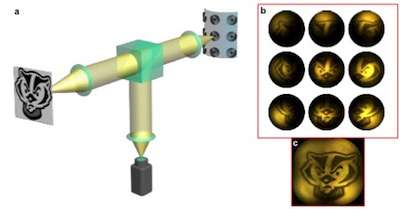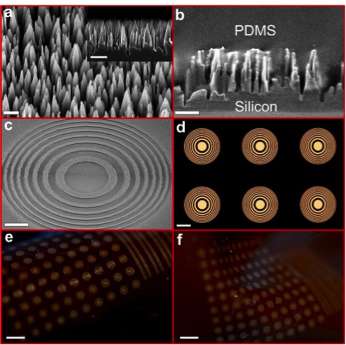Minuscule, flexible compound lenses visualize vast fields of view

Drawing inspiration from an insect's intricate eye, University of Wisconsin-Madison engineers have created miniature lenses with vast range of vision.
Their novel approach allowed them to create the first-ever flexible, Fresnel zone plate microlenses with a wide field of view—a development that could allow everything from surgical scopes to security cameras to capture a broader perspective. Led by Hongrui Jiang, the Vilas Distinguished Achievement Professor and Lynn H. Matthias Professor in electrical and computer engineering at UW-Madison, the researchers described the advance in the October 30th issue of the journal Scientific Reports.
The advance centers around a method for creating tiny lenses, each the size of a grain of salt, embedded within a flexible plastic polymer. This approach allowed the researchers to bend an array of multiple lenses into a cylindrical structure. An array of these miniscule lenses, each no larger than a head of a pin, can capture an almost complete panorama, producing images from a 170-degree field of view.
"We got the idea from compound eyes," says Jiang. "We know that multiple lenses on a domed structure give a large field of view."

He sees potential for this work to improve surgical scopes and security cameras—offering a wide range of vision for devices at a fraction of the size required by conventional lenses.
The imitation insect eyes not only capture a large field of view, they also contort and flex. Each tiny lens sits within a flexible plastic polymer material, which allows the researchers to freely reconfigure the shape of the lens array. Jiang and colleagues can manipulate their micro-lenses in this manner because rather than relying on conventional optics for focusing, they used Fresnel zone plates. "Usually flexible structures are incompatible with optics, but our lenses are small and the optical properties are fine," says Jiang.
Typical lenses consist of stiff translucent materials, machined into concave or convex shapes; they obtain images by changing the trajectory of incoming light into a single focal point through refraction. Fresnel zone plate lenses, by contrast, focus light through constructive and destructive interference, or diffraction.
Each of Jiang's half-millimeter diameter lenses resembles a series of rings on the surface of still water emanating outward from a single point. In bullseye-fashion, each concentric ring alternates between bright and dark. The distance between the rings determines the optical properties of the lens—and the researchers can tune the optical properties of a single lens by stretching and flexing it.
Previous attempts at creating Fresnel zone plate lenses have suffered from fuzzy vision. "The dark areas must be very dark," explains Jiang. "Essentially, it has to absorb the light completely. It's hard to find a material that doesn't reflect or transmit at all."
His team overcame this obstacle by using black silicon to trap light inside the dark regions of their Fresnel zone plate lenses. Black silicon consists of clusters of microscopic vertical pillars, or nanowires. Incoming light bouncing between individual silicon nanowires cannot escape the complex structure, making the material darker-than-dark.
Rather than laying down layers of black silicon on top of a clear backdrop, Jiang and his team took a bottom-up approach to generate their lenses. First they patterned aluminum rings on top of solid silicon wafers using lithography, and etched silicon nanowires in the areas between aluminum rings. Then they seeped a polymer between the silicon nanowire pillars. After the plastic support solidified they etched away the silicon backing, leaving bullseye-patterned black silicon embedded in supple plastic. This approach gave their lenses unprecedented crisp focusing capabilities as well as the flexibility that enables them to capture a large field of view.
Currently Jiang and his team are exploring ways to implement these microlenses into real-world applications. They are working to integrate the lenses into existing optical detectors and directly incorporate silicon electronic components into the lenses themselves.
More information: Mohammad J. Moghimi et al. Micro-Fresnel-Zone-Plate Array on Flexible Substrate for Large Field-of-View and Focus Scanning, Scientific Reports (2015). DOI: 10.1038/srep15861
Journal information: Scientific Reports
Provided by University of Wisconsin-Madison

















